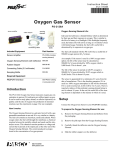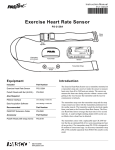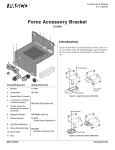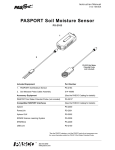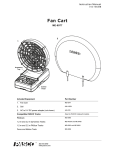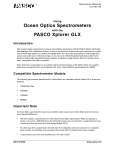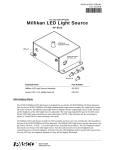Download PASCO Specialty & Mfg. 2-channel User's Manual
Transcript
Instruction Sheet 012-10253A 1 MHz 2-channel Voltage Sensor PS-2190 Introduction The 1 MHz 2-channel Voltage Sensor is a high speed, two channel PASPORT voltage sensor that has a basic voltage range of ±10 volts. It has amplifiers that allow full-scale input ranges of ±1 volt and ±0.1 volt. The sensor uses an oversampling scheme that allows input sampling at speeds up to one million samples per second. The 1 MHz 2-channel Voltage Sensor connects to a PASPORT Xplorer GLX datalogger. Measurements are recorded and displayed by the datalogger. Included Equipment • 1 MHz 2-channel Voltage Sensor Additional Equipment Required • Xplorer GLX datalogger (PS-2002) • Patch Cords (SE-9750 or SE-9751) 2. Connecting the Sensor to an Xplorer GLX Datalogger Plug the sensor into any port on the top of the PASPORT Xplorer GLX datalogger. The Xplorer GLX screen will automatically show a Graph display of voltage versus time. Quick Start 1. Set-up Connect the 1 MHz 2-channel Voltage Sensor to your PASPORT Xplorer GLX datalogger. Use patch cords to connect Channel 1 and Channel 2 to the parts of the circuit for which you want to measure the voltage. 3. On the Xplorer GLX, press the start button (s) to begin recording data. 4. When data recording is done, press the start button again to stop recording data. Setting Sensor Parameters Sample rate, data averaging, and input voltage range are set in the Sensors screen. • Press the Home button (h) to open the Home screen. • Press F4 (I) under Sensors in the Home screen to open the Sensors screen. The sensor measures up to two voltages simultaneously at speeds up to one million samples per second when used with the GLX in oscilloscope mode. Figure 1: Sensor screen ® 1 M H z 2 - c h a n n e l V o lt a g e S e n s o r The Sensors screen shows the icon and name of the sensor in the upper left corner, and menus for Sample Rate Unit, Sample Rate, Reduce/Smooth Averaging, Channel 1, and Channel 2. Sample Rate in the Sensors Screen By default, the sensor collects data at 10,000 samples per second. To change the Sample Rate, for example, use the down cursor button (d) to select the menu. Use the ‘plus’ or ‘minus’ buttons (-+) to increase or decrease the sample rate, or press the check button (c) to open the menu. Use the up or down cursor buttons to highlight the sample rate and press the check button again to select the choice and exit the menu. The maximum sample rate that can be selected in the Sensors screen is 20,000 Hz For faster sampling, see “Scope Mode Sample Rate Selection”.. PS-2190 Selecting Scope Mode The 1 MHz 2-channel Voltage Sensor is designed to be used with the Xplorer GLX in Scope Mode where the maximum sample rate of 1,000,000 Hz can be selected. Press the Home button to open the Home screen. Press the F1 button (F) under ‘Graph’ to open the Graph screen. Press the F4 button (I) under ‘Graphs’ to open the menu. The menu choices are numbered. Press the number button of the number of your choice (for example, ‘Scope Mode’), or use the up and down arrow buttons to highlight your choice and then press the check button (c) to select the choice and close the menu. Figure 4: Select Scope Mode Figure 2: Select sample rate Selecting Voltage Range By default, the input voltage range for both channels is ±10 V. To change the input voltage range for either Channel 1or Channel 2 or to make the channel ‘not visible’, use the up or down cursor buttons to highlight the menu and press the check button (c) to open the menu. The menu choices are numbered. Press the number button for the number of your choice to select the choice and close the menu, or use the up or down cursor buttons to highlight your choice and then press the check button to select the choice and close the menu. The Graph screen changes slightly -- the ‘zero’ on the vertical axis becomes an ‘x’-- to indicate that the Graph is in the Scope Mode. The ‘Trigger’ choice in the Tools menu is also automatically selected. Scope Mode Sample Rate Selection To change the sample rate in Scope Mode, press the F2 (G) button under ‘Scale/Move’ in the Graph screen. To increase the sample rate, press the right cursor button (r). To decrease the sample rate, press the left cursor button (l). As you increase the sample rate by rescaling the Time (s) axis with the ‘Scale/Move’ tool, the units will change from seconds (s) to milliseconds (ms) and -- ultimately -- microseconds (µs). Figure 3: Select input voltage range The input voltage range for each channel can be set independently. 2 Figure 5: Sample rate in Scope Mode ® 1 MHz 2-channel Voltage Sensor The sample rate is linked to the time resolution on the horizontal axis. For example, when the horizontal axis scale is 0 to 10 ms, the sample rate in the Sensor Settings screen is 20,000 Hz. When the horizontal scale is 0 to 5 ms, the sample rate is 50,000 Hz. When the horizontal scale is 0 to 2 ms, the sample rate is 100,000 Hz. When the horizontal scale is 0 to 2 µs, the sample rate is 1,000,000 Hz. PS-2190 Use the up arrow cursor button to increase the Trigger Level. Use the down arrow cursor button to decrease the Trigger Level. A horizontal dashed line appears on the graph indicating the Trigger Level. ‘Rising’ edge Use of this dynamic sample rate adjustment accomplishes two purposes: It simplifies adjustment of the Graph to obtain a good representation of the input and it allows the sensor to perform averaging of the input signal at lower sample rates and thereby reduce noise that might be part of the signal. Trigger Settings The Trigger choice in the ‘Tools’ menu is automatically selected when you select Scope Mode. Press the F3 (H) button to open the Tools menu. The Trigger is a tool that allows you to control how the GLX collects data. With the Trigger, you make the GLX delay data recording (after you press s) until a certain condition is met by the incoming data. The Trigger has two parameters: Trigger Edge, which can be ‘Rising’ or ‘Falling’, and Trigger Level, which specifies the data value that must be crossed. Press the left arrow cursor button (l) to open the Trigger Settings dialog box (you can also select it from the Tools menu). By default, the Trigger is ‘Disabled’, the Trigger Edge is ‘Rising’, the Trigger Level is ‘0.00’ and the Stop Condition is ‘Off’. Figure 7: Trigger Level Press the right arrow cursor button to cycle through ‘Rising’ edge, ‘Falling’ edge, and ‘Disabled’ Stop Condition When the Stop Condition is turned on, data collection stops automatically when the GLX reaches the right-hand edge of the Graph. To turn on the Stop Condition in the Trigger Settings screen, use the arrow cursor buttons to highlight Stop Condition and press c. When the Stop Condition is on, an icon and a vertical dashed line appear on the Graph indicating the stop time. Stop Condition icon Figure 6: Trigger Settings Use the up or down cursor buttons to highlight your choice and then press the check button (c) to change the selection (e.g., from ‘Disabled’ to ‘Enabled’). When the Trigger is ‘Enabled’, an arrow appears along the vertical axis at the Trigger Level. For Trigger Level, press the check button to highlight the numeric value and use the alphanumeric key pad to enter a new value and then press c again. Press the F1 (F) button to select ‘OK’ or the F2 (G) button to select ‘Cancel’. Trigger in the Graph Display The Trigger can be used in normal graph mode to start continuous recording, or it can be used in Scope Mode to repeatedly trigger bursts of data collection. In both modes, the Graph must have time on the horizontal axis. ® Figure 8: Stop Condition While viewing the Graph, hold e and press the left and right cursor arrow buttons to adjust the stop time. The amount of data collected is determined by the Graph’s time scale. About the Sensor Front Panel Indicators The front panel has two light-emitting diode (LED) indicators. The green LED indicates ‘power on’ when the sensor is connected to the Xplorer GLX datalogger. The yellow LED lights whenever the sensor detects a signal that meets the trigger requirements set up in the GLX. 3 1 M H z 2 - c h a n n e l V o lt a g e S e n s o r PS-2190 Trigger In-Out The PS-2190 has two BNC connectors on the rear panel labeled Trigger In and Trigger Out. By connecting the Trigger Out of one PS-2190 to the Trigger In of a second PS-2190, the two sensors are time synchronized and four channels can be measured. Since the Xplorer GLX can currently only display two channels in Scope Mode, this feature is for future use. RL Circuit Figure 8: Rear Panel Basic Specifications Channels two, differential Maximum Sample Rate (Burst Mode) 1 million samples per second Maximum Sample Rate (Continuous Mode) 20,000 sample per second Input Voltage Ranges ±10 V, ± 1 V, ± 0.1 V full scale Resolution 12-bit analog-to-digital converter, 5 mV at ±10 volts Analog Bandwidth 120 kiloHz (-1 dB) typical Absolute Maximum Input Voltage Without Damage 45 volts • • Technical Support For assistance with any PASCO product, contact PASCO at: Address: PASCO scientific 10101 Foothills Blvd. Roseville, CA 95747-7100 Suggestions • RC Circuit Measure the voltage of a resistor-inductor-capacitor (RLC) circuit as an input AC voltage sine waveform ranges from below resonant frequency to above resonant frequency. Measure the voltage of a resistor-inductor (RL) circuit with an input AC voltage square waveform at 50 Hz. Measure the voltage of a resistor-capacitor (RC) circuit as the capacitor charges and discharges through the resistor. Phone: +1 916-786-3800 (worldwide) 800-772-8700 (U.S.) Fax: (916) 786-7565 Web: www.pasco.com E-mail: [email protected] For more information about the 1 MHz 2-channel Voltage Sensor and the latest revision of this Instruction Sheet, visit: www.pasco.com/go?PS-2190 RLC Circuit 4 Limited Warranty For a description of the product warranty, see the PASCO catalog. Copyright The PASCO scientific 012-10253A 1 MHz 2-channel Voltage Sensor Instruction Sheet is copyrighted with all rights reserved. Permission is granted to non-profit educational institutions for reproduction of any part of this manual, providing the reproductions are used only in their laboratories and classrooms, and are not sold for profit. Reproduction under any other circumstances, without the written consent of PASCO scientific, is prohibited. Trademarks PASCO, PASCO scientific, DataStudio, and PASPORT are trademarks or registered trademarks of PASCO scientific, in the United States and/or in other countries. All other brands, products, or service names are or may be trademarks or service marks of, and are used to identify, products or services of, their respective owners. For more information visit www.pasco.com/legal. ®





